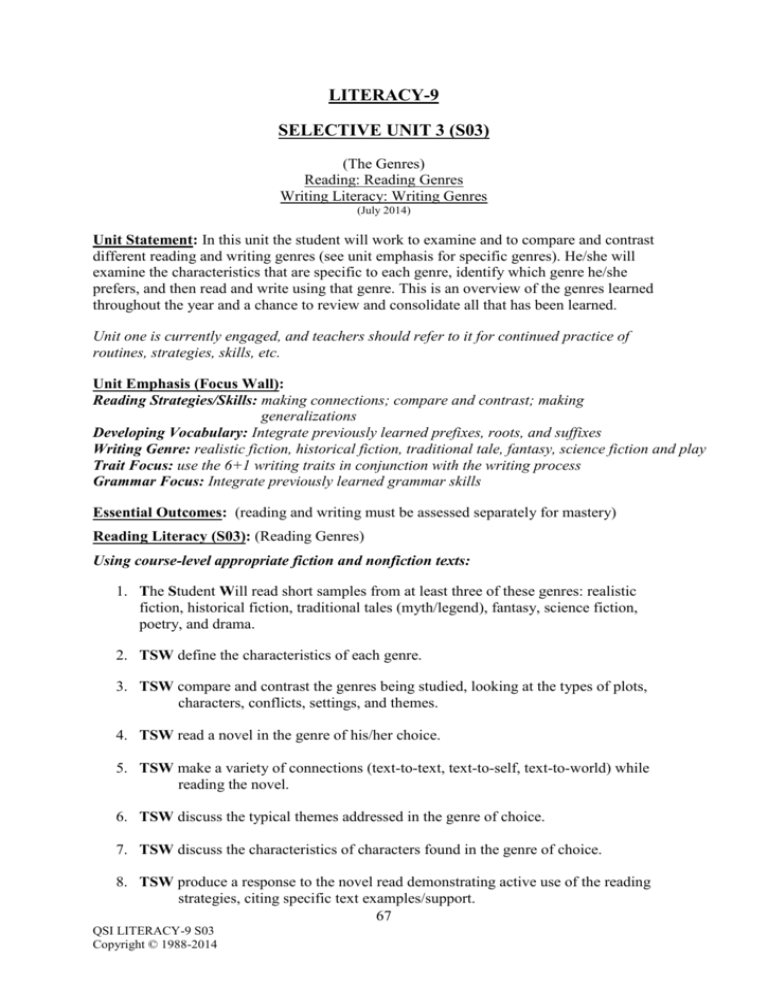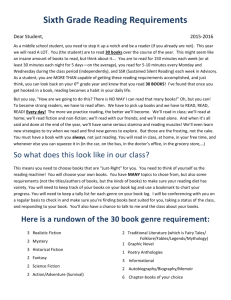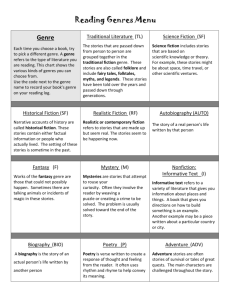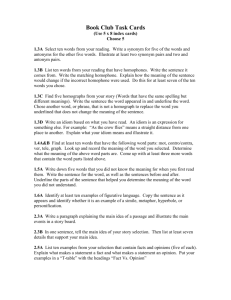LITERACY 9 S03
advertisement

LITERACY-9 SELECTIVE UNIT 3 (S03) (The Genres) Reading: Reading Genres Writing Literacy: Writing Genres (July 2014) Unit Statement: In this unit the student will work to examine and to compare and contrast different reading and writing genres (see unit emphasis for specific genres). He/she will examine the characteristics that are specific to each genre, identify which genre he/she prefers, and then read and write using that genre. This is an overview of the genres learned throughout the year and a chance to review and consolidate all that has been learned. Unit one is currently engaged, and teachers should refer to it for continued practice of routines, strategies, skills, etc. Unit Emphasis (Focus Wall): Reading Strategies/Skills: making connections; compare and contrast; making generalizations Developing Vocabulary: Integrate previously learned prefixes, roots, and suffixes Writing Genre: realistic fiction, historical fiction, traditional tale, fantasy, science fiction and play Trait Focus: use the 6+1 writing traits in conjunction with the writing process Grammar Focus: Integrate previously learned grammar skills Essential Outcomes: (reading and writing must be assessed separately for mastery) Reading Literacy (S03): (Reading Genres) Using course-level appropriate fiction and nonfiction texts: 1. The Student Will read short samples from at least three of these genres: realistic fiction, historical fiction, traditional tales (myth/legend), fantasy, science fiction, poetry, and drama. 2. TSW define the characteristics of each genre. 3. TSW compare and contrast the genres being studied, looking at the types of plots, characters, conflicts, settings, and themes. 4. TSW read a novel in the genre of his/her choice. 5. TSW make a variety of connections (text-to-text, text-to-self, text-to-world) while reading the novel. 6. TSW discuss the typical themes addressed in the genre of choice. 7. TSW discuss the characteristics of characters found in the genre of choice. 8. TSW produce a response to the novel read demonstrating active use of the reading strategies, citing specific text examples/support. 67 QSI LITERACY-9 S03 Copyright © 1988-2014 Writing Literacy (S03): (Writing Genres) 1. The Student Will brainstorm a list of possible genres. 2. TSW choose a specific genre and write an outline for it. 3. TSW develop characters that are specific to that genre. 4. TSW develop a setting and plot that are specific to that genre. 5. TSW publish a story in the genre of his/her choice using the writing process. Introduced Outcomes: (taught, but not assessed) 1. The Student Will look for a repeated theme or idea addressed in multiple genres by the same author. 2. TSW discuss how a text would be different if it were written in another genre. Practiced/Ongoing Outcomes: (ongoing development, but not assessed) 1. 2. 3. 4. TSW acquire and use new vocabulary in reading, writing, and speaking. TSW demonstrate age appropriate spelling in their writing. TSW practice properly formed handwriting techniques. TSW apply previously learned prefixes, roots, and suffixes in determining the meaning of age-appropriate words. 5. TSW Integrate previously learned grammar skills. Key Terms and Concepts: Reading realistic fiction traditional tale legend science fiction Writing same as reading historical fiction myth fantasy play Suggested Materials for Teachers: (provided by school) *See Essential Unit 1 Journeys Language and Literacy Guide (p. 248 - 257) Suggested Professional Materials for Teachers: (provided by school) *See Essential Unit 1 Suggested Exemplar Texts (read alouds): The Last of the Really Great Whangdoodles - Julie Andrews Edwards The Lion, the Witch, and the Wardrobe - C. S. Lewis The BFG - Roald Dahl Charlie and the Chocolate Factory - Roald Dahl How Many Spots Does a Leopard Have? and Other Tales - Julius Lester 68 QSI LITERACY-9 S03 Copyright © 1988-2014 The City of Ember - Jeanne DuPrau Additional Resources: (may not be provided by school) *See Essential Unit 1 The Usborne Illustrated Guide to Greek Myths and Legends - by Cheryl Evans Technology Links: *See Essential Unit 1 Destiny Webpath Express (found in school library) http://www.flashcardmachine.com/genres-for-4thgradersyork.html Genre flashcards with explanations http://www.myteacherpages.com/webpages/cbarnes/resources.cfm Fiction genres listed with short explanations http://kellyteachingcorner.blogspot.com/2012/08/teaching-genres.html Anchor chart ideas http://greece.mrdonn.org/myths.html A site containing numerous Greek myths written for children http://www.activityvillage.co.uk/greek-myths More Greek myths http://www.ducksters.com/history/ancient_greek_mythology.php Information on the Greek gods http://monsters.monstrous.com/index.htm A site containing descriptions and pictures of mythological monsters Suggested Activities: ● Anchor Charts - Create and reference anchor charts when modeling how to read and write. Students will use these to reference when it's his/her turn to work independently. ○ The Genres (showing each genre with a brief definition) ● Focus Wall- Create a wall with all the genres, a list of genre characteristics, lists of writing ideas, editing checklists, etc. ● Genre Rewrite - Rewrite a text, incorporating its theme, in a different genre ● Represent the Genre - Students each research a different genre; they all come to class prepared to discuss and debate why their genre is “best.” Suggested Assessment Tools: 1. Attached rubric or teacher-generated rubric that assesses ALL essential outcomes (TSWs). An effective rubric is presented and discussed with the student at the beginning of the unit, referred back to throughout the unit, and used to assess at the end. Students will collaborate with peers and the teacher to assess their own writing with final judgment by the teacher. 2. Writing Pathways (Units of Study Kit) by Lucy Calkins provides rubrics and checklists for teachers and students. 69 QSI LITERACY-9 S03 Copyright © 1988-2014 3. “6+1 Traits” writing rubrics 4. Teachers can have students produce a quick write at the beginning and end of units. (*See QSI Quick Write Guidelines) Teachers should keep these as evidence of students’ writing. 5. Elk Grove Common Core Rubrics for narrative, informative, and opinion writing are found in the QSI Literacy User’s Guide. Scoring on these rubrics should follow QSI mastery grading. (Scores on the 1 and 2 points should be P, scores on the 3 should be at the B level and scores on the 4 should be an A.) Document Source: Elk Grove Unified School District, Elk Grove, CA 6. Fountas and Pinnell Benchmark Assessment / DRA 7. QSI Reading and Writing Behaviors Checklists (*See QSI Literacy User’s Guide) RUBRICS FOUND ON FOLLOWING PAGES……………………… 70 QSI LITERACY-9 S03 Copyright © 1988-2014 LITERACY-9 Reading: Reading Genres (S03) Student Name: ________________________________________ Date: ____________________ To receive a ‘B’ the student must show ‘B’ level mastery on ALL Essential Outcomes. (TSW’s) To receive an ‘A’, the student must show ‘A’ level mastery on ALL available and ‘B’ level mastery on all remaining TSW’s. TSW ‘A’ Level ‘B’ Level 1. Read samples from each of these genres: realistic fiction, historical fiction, traditional tales, fantasy, science fiction, and drama. I have read texts from each of these genres. 2. Define the characteristics of each genre. I can define the characteristics of each genre. 3. Compare and contrast the genres being studied, looking at the types of plots, characters, conflicts, settings, and themes. I used specific examples and details while comparing and contrasting the genres. 4. Read a novel in the genre of his/her choice. 5. Make a variety of connections (text-to-text, textto-self, text-to-world) while reading the novel. I compared and contrasted the story elements in each of the genres that we studied. I have read a novel in a specific genre that I chose. My connections show deep engagement with the text and higher level thinking. I have made text-to-text, text-to-self, and text-toworld connections while reading my novel 6. Discuss the typical themes addressed in the genre of choice. I can discuss the types of themes used in the genre I chose. 7. Discuss the characteristics of characters found in the genre of choice. I can talk about the kind of characters found in my chosen genre. 8. Produce a response to the novel read demonstrating active use of the reading strategies, citing specific text examples/support. My response explains how using the strategies helped me gain a better, deeper understanding of the story and its parts. I go beyond the text in my response. My literature response shows how I used the reading strategies I have learned. I used specific examples/support from my novel. 71 QSI LITERACY-9 S03 Copyright © 1988-2014 ‘P’-Notes LITERACY-9 Writing: Writing Genres Rubric (S03) Student Name: Date: ____________________________________ To receive a ‘B’ the student must show ‘B’ level mastery on ALL Essential Outcomes. (TSW’s) To receive an ‘A’, the student must show ‘A’ level mastery on ALL available and ‘B’ level mastery on all remaining TSW’s. TSW ‘A’ Level ‘B’ Level 1. brainstorm a list of possible genres. I have a list of possible genres. 2. choose a specific genre and write an outline for it. I chose a genre and wrote an outline for it. 3. develop characters that are specific to that genre. I have created a genre “warp” and used characteristics from several genres clearly and effectively to develop my characters. The characters I used have characteristics that are specific to my genre. 4. develop a setting and plot that are specific to that genre. I have created a genre “warp” and used characteristics from several genres clearly and effectively to develop my setting and plot. The setting and plot I used are specific to my genre. 5. publish a story in the genre of his/her choice using the writing process. My story shows a I used a theme from my strong grasp of the favorite genre to write a necessary short story. characteristics of this genre. 72 QSI LITERACY-9 S03 Copyright © 1988-2014 ‘P’-Notes







